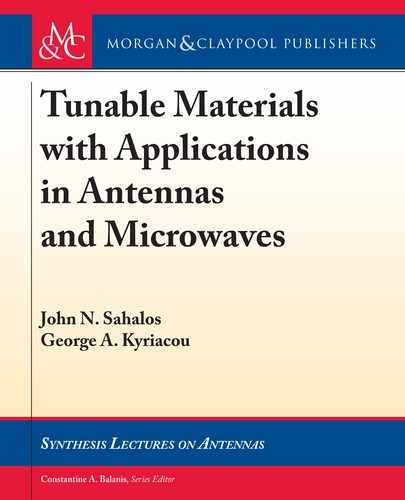
4.5. REFERENCES 177
where a D a
ij
is the linear magneto-electric coefficient, while ˇ
ijk
and
ijk
represents the higher-
order magneto-electric effects which are usually negligibly small with respect to a
ij
.
An interesting example of multiferroics adopted from [1] and the original references
therein is presented in Figure 4.3. is refers to three different bilayers laminate compos-
ite: (i) nickel ferrite (NiFe
2
O
4
)/PZT, (ii) lithium ferrite/PZT, and (iii) yitrium iron garnet
(YIG)/PZT. For practical applications, these composites are subject to a constant static magnetic
field H
DC
(e.g., provided by a permanent magnet) to be selected with the aid of diagrams like that
of Figure 4.3, while their ferromagnetic resonance (FMR) will be tuned by a static electric field.
e above figure presents the magnetic susceptibility
m
vs. the static magnetic field (H
DC
) with-
out an external DC electric field (curves green) and with a strong electric field E
DC
D 300 kV/cm
(curves red). e stronger tunability is observed for the nickel ferrite (NFO/PZT), and a useful
tunability is observed for the lithium ferrite/PZT, while a negligible tunability is observed for
YIG/PZT bilayer.
Magnetic Susceptibility (Real)
Static Magnetic Field (Oe)
12
8
4
0
-4
-8
-12
5,400 6,075 6,750 7,425
9.3 GHz
YIG-PZT
NFO-PZT
LFO-PZT
E = 0
E = 300 kV/cm
Figure 4.3: eoretical electric field magnetic tunability for three bilayers: (i) nickel ferrite
(NiFe
2
O
4
)/PZT, (ii) lithium ferrite/PZT, and (iii) yitrium iron garnet (YIG)/PZT. E
DC
can
be obtained by a DC voltage of 30 V for a thin film composite with thickness of 1 m [1].
Further details regarding simulation and modeling of multiferroics can be found in the
excellent review papers [1, 4] and the original references therein.
Multiferroics are very promising tuning materials in antenna and microwave applications
and there is much research work to be done in the near future.
4.5 REFERENCES
[1] Ce-Wen Nan, M. I. Bichurin, S. Dong, D. Viehland, and G. Srinivasan, Multiferroic
magnetoelectric composites: Historical perspective, status, and future directions, Journal
of Applied Physics, vol. 103, 031101, 2008. xvi, 171, 172, 173, 175, 176, 177
178 4. MULTIFERROICS: FERRITE–FERROELECTRIC COMPOSITES
[2] S. Fusil, V. Garcia, and A. Barthélémy, Magnetoelectric devices for spintronics, Annual
Review of Materials Research, vol. 44, pp. 91–116, 2014. First published online as a Review
in Advance on March 21, 2014. DOI: 10.1146/annurev-matsci-070813-113315. 172
[3] O. Rybin and S. Shulga, Profile miniaturization and performance improvement of a rect-
angular patch antenna using magnetic metamaterial substrates, International Journal of
RF and Microwave, Wiley, 2016. xvi, 172, 173, 174
[4] L. W. Martin, S. P. Crane, Y-H Chu, M. B. Holcomb, M. Gajek, M. Huijben, C-
H Yang, N. Balke, and R. Ramesh, Multiferroics and magnetoelectrics: in films
and nanostructures, Journal of Physics: Condensed Matter, 20, 2008, 434220. DOI:
10.1088/0953-8984/20/43/434220. 172, 176, 177
[5] R. E. Newnham, D. P. Skinner, and L. E. Cross, Connectivity and piezoelectric-
pyroelectric composites, Materials Research Bulletin, vol. 13, no. 525, 1978. DOI:
10.1016/0025-5408(78)90161-7. 174
[6] J. Lou, M. Liu, D. Reed, Y. Ren, and Nian X. Sun, Giant electric field tuning of mag-
netism in novel multiferroic FeGaB/Lead zinc niobate–lead titanate (PZN-PT) het-
erostructures, Advanced Materials, Wiley, 2009. 175
[7] J. Ma, J. Hu, Z. Li, C.-W. Nan, Recent progress in multiferroic magnetoelectric com-
posites: from bulk to thin films, Advanced Materials, Wiley, 2011. 176
..................Content has been hidden....................
You can't read the all page of ebook, please click here login for view all page.
